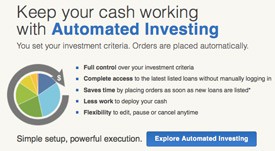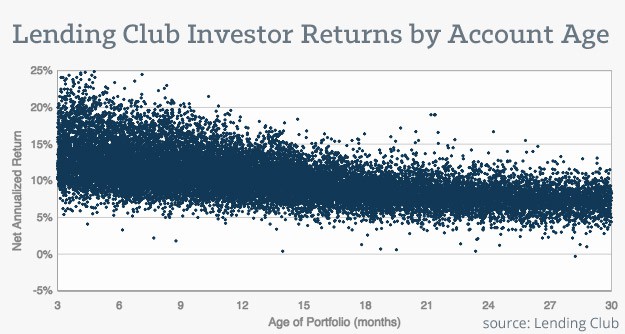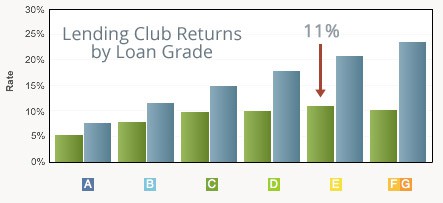Getting fully situated as a peer to peer lender can take some time. For one, a prospective investor has to learn the basics of how this entire thing works, how their cash is invested into worthy loans, and how these borrowers then pay these loans back with interest. Second, new investors have to become familiar with one of the two exchanges, getting to know Lending Club or Prosper and the way their websites work. Despite peer to peer lending being somewhat simple as an investment, the typical investor’s initial experience can contain a bit of a learning curve.
That said, once an investor is used to the process, the investment can take on a very different feel. It can almost become boring. Like learning how to drive a car, the initial period may be exciting or stressful, but eventually things settle down. Eventually, peer to peer lending can become kind of dull.
If investing is exciting, you’re doing it wrong.
This isn’t a bad thing. Quite the opposite; it’s an indicator of its inherent stability! There is this great maxim I read that said, “If investing is exciting, you’re doing it wrong.” Our investing, like vacuuming the house or visiting the dentist, should be typified by how important and uneventful it is.
6 Signs You’re a Seasoned Peer to Peer Lender
To illustrate this, here are six signs you have become acclimated to peer to peer lending:
#1. You have automated your investing
 For beginner investors, many feel the need to pick their invested loans one by one, reading the descriptions and getting a feel for the people they will lend their money to. I did this myself, at first. But eventually lenders realize that reading each loan is a time consuming process. If they are going to diversify their account in over 200 loans, this would mean reading hundreds and hundreds of loan descriptions. And what makes a good description? Good spelling? A credit history with a low number of late payments?
For beginner investors, many feel the need to pick their invested loans one by one, reading the descriptions and getting a feel for the people they will lend their money to. I did this myself, at first. But eventually lenders realize that reading each loan is a time consuming process. If they are going to diversify their account in over 200 loans, this would mean reading hundreds and hundreds of loan descriptions. And what makes a good description? Good spelling? A credit history with a low number of late payments?
Seasoned investors are often unaware of the specific loans they have invested in. Indeed, they have often set up Lending Club’s Automated Investing or Prosper’s Automated Quick Invest to place their available cash in more loans automatically, perhaps while using a filter. Seasoned investors typically trust the overall underwriting of the platforms to such a degree that automated investing makes a lot of sense and saves them a ton of time.
#2. You rarely check your investment
When investors start out, they sometimes feel the need to check on their investment every day. This is understandable, as many have never seen a loan payment before, or perhaps are curious what their initial return will be once payments start coming in. And most are curious to see if a borrower will default on his or her loan, particularly how this default will impact their overall return.
But eventually, an investor will experience the full gamut of peer to peer lending. They have loans go late but become current again. They have loans go late and eventually default. Their deposits are invested in loan after loan until they run out. Their ROI initially jumps really high, but eventually settles down as well.
Seasoned investors often have seen it all. With a return that largely remains unchanged from month to month, seasoned investors can go weeks without checking their accounts. For example, I did not check on my personal Prosper investment for over a month until my most recent portfolio update. Yet my ROI was unchanged from last quarter. And this account is only in month 12. Accounts don’t typically stabilize until 18 months have passed, so my most boring months are yet to come.
#3. Your overall return has settled between 5-10%
Early investors experience incredibly high returns. This is because their ROI typically reflects the interest rate of the loans they have invested in, since their loans have not had the chance to default. As the average interest rate on p2p loans is around 14-15%, many investors experience initial returns that mirror this rate.
However, defaults always come, and often in a flurry. That 15% return on month 2 begins to drop, and continues to do so each month for the next year and a half, often stabilizing around month 18 (read: The Return Curve in P2P Lending). New investors can find this process unnerving, especially at first when the drops are the greatest.

Seasoned investors generally don’t experience such precipitous declines in their ROI. Instead, the return on their diversified investment has come to mirror the platform investor average, settling between 5 and 10 percent as seen in the Lending Club graph above.
#4. You opened an IRA with Lending Club or Prosper
For prospective peer to peer investors, their initial trial investment is often some small trial amount in the safest available loans (read: How to Try P2P Lending with $2,000). This allows them to get a feel for peer to peer lending while having the lowest chance of losing money. Many new investors have a great experience with this initial account, going on to invest additional deposits into a wider variety of loan grades.
That said, seasoned investors have come to trust peer to peer lending to such a degree that they open a retirement account at Lending Club or Prosper (read: How to Retire Wealthy with a P2P IRA). These investors realize that p2p lending does not have a special tax rate, unlike capital gains. Considering many stand to lose a third of their investment to these taxes, a tax-incentivized Roth IRA makes a lot of sense, and these investors look forward to withdrawing their earnings tax-free when they turn 60.
#5. You have chosen to take on more risk
Beginner investors can feel uncertainty toward this asset class. After all, investments like stocks and bonds have been around for some time. But peer to peer lending has been around for less than a decade. To combat this lack of familiarity, early investors often choose to fund the safest A-grade or AA-grade loans they can find. Some, like myself, might feel safe enough to make their early investments in C-grade loans, but most stick to the As and Bs.

Seasoned investors, on the other hand, have often shifted to embrace more risk, filling their portfolio with more of the C through G-grade loans. My favorite example of this is Jack’s Reader Story, where he describes his overall return climbing dramatically when he changed his investing strategy from safer to riskier:
“I am happy with my returns since I changed my risk tolerance from ultra-conservative to somewhat aggressive. At that time, we were coming off of the 2008 financial crisis, so I only invested in A and B-grade loans.
After one year, I switched to loan grades of C and below, since it seemed people were getting better returns in these riskier loans without a large increase in defaults. On Lending Club, I went from an 8% to almost a 10% return in the past 18 months by switching to this strategy.”
This does not mean it is right for everyone to take on lots of risk. Many investors, particularly those later on in their lives, experience adequate returns in the safer grades. However, it is quite common for investors to take on more risk as p2p lending becomes more familiar to them.
#6. You’ve given up trying to convince your friends
Many new investors can’t believe how novel and lucrative peer to peer lending is. They are amazed by how simple it feels when compared to a dizzy investment like the stock market. They love its inherent stability and the control it offers them over their own retirement account. These investors sometimes become huge proponents of peer to peer lending. They may talk about it to their friends and family, giving solid reasons why they should adopt it as well.
Seasoned investors have often tried and given up on this errand. While perhaps influencing a friend or two, most investors have realized how difficult it is to change people’s habits, and have instead become content with their own returns. They may hope for p2p lending to become a national trend, influencing their community in ways they themselves are unable to, but until then their investing is largely done independent of their social circle.
P2P Lending: A Cutting-Edge, Lucrative, & Uneventful Investment
Our personal finances provide our lives with a frame, a frame upon which we can fill with people and experiences that make life worth living. This frame is really important. It has to be strong and dependable throughout all of life’s twists and turns. But in the end, it’s just the frame. It is boring to look at, and even more boring to live for.
Peer to peer lending is, at its best, part of that frame. It contains refreshing potential, offering us a stable investment if we do it properly, and this can be seen in the solid yield it continues to offer us. That said, peer to peer lending is largely uneventful once enough time has passed. There are situations where this could change (an increase in unemployment, etc), but largely our experience as investors has been the same year by year.
This uneventful stability is just another indicator of peer to peer lending’s inherent quality, and may be what eventually convinces our country to adopt it as a widespread practice. I believe most investing professionals, including those managing hundreds of employee retirement plans, will be more eager to jump into this asset class once it has had an uneventful 5-10% return for 8-10 years.
What do you think? Did I miss any?
[image credit: Randy Pertiet “Cowboy # 3” CC-BY 2.0]

Disagree with #5 and the focus on E (high risk) notes. While that is anecdotally one strategy that some adopt, I’m not sure how you can claim it’s a characteristic of being seasoned (implying, apparently, that it is a wise approach). After all, if the average overall return is 5-10%, one can achieve that return with a much better risk profile by investing in B/C grades. So those 2 points contradict in my mind. E’s will by nature have a much higher rate of default, and a full economic cycle that includes tough times / recession will show E to be quite risky.
And apologies for being cynical but I also think a focus on E grade loans contradicts your previous article on P2P lending being “beautiful” for borrowers. Personally I would never, ever advise anyone to take out a loan at E rates (20% interest). It’s extremely high for the average person and probably a bad idea — I can’t imagine feeling great about taking a loan with those terms.
Again, sorry for the cynicism but occasionally someone needs to chime in with a sanity check.
Hi RJ. Thanks for your comment. I’m not suggesting that a portfolio with E-grade notes is smart for every investor. I am suggesting that many investors (like Jack) take on additional risk as they become more acclimated, that this could be a sign an investor has explored this asset class, is seasoned, and feels comfortable enough to seek out the scarce E grades, despite, as you accurately point out, their default rate and volatility increasing.
As for borrowers taking out loans with 20% interest rates being a bad idea, I think it depends on the situation. For debt consolidators, some may actually save a few percentage points while also moving from 3-6 dizzying variable rate revolving lines into just one with a fixed rate and term. Sounds like a beautiful change of pace to me.
Do I suggest this to everyone? Definitely not. 20% is still a remarkably high interest rate on a fresh line of credit. But for those who are already leveraged, approval can be fresh news indeed.
Great post again Simon. I have been investing since 2008 (Mostly LendingClub) and for the past few years have been fully automated on the platform and my returns hover around high 9%-10%. I remember once when I first started Jan 2008 I proposed the idea of p2p lending to a finanical advisor at USAA without mentioning lendingclub and she thought it was far fetched and uber risky!
That was before the SEC got involved and in my eyes is true P2P lending. As now it’s notes w/a prospectus issued by a bank that everyone is investing in, do you foresee any possible downsides to this regulation in the future? I also recently read a blog post (I think at MyMoneyBlog) about how LendingClub/Prosper will start generating worse returns for the average guy due to the shift to big money institutions grabbing up the more desirable notes before retail investors. I think also he mentioned the incentive for them to lower their standards for borrowers to increase their company growth. Do you think this is a valid concern?
Hi Sean,
Thanks for your comment. There are certainly a number of downsides to the regulation the SEC imposed on p2p, for instance, it now has the strict requirements of the securities industry (IE: professional advisors have to be SEC approved). That said, I think the regulation has mostly been a positive thing. Of course, as the government continues to look at p2p and consider additional regulation, there is always the chance they will add some new requirement that significantly changes everybody’s experience. Such a turn of events would rock the industry. That said, I think people like LC & P are so tied in with the national regulators that most of the major adjustments have already been pushed through, and any additional shifts are more likely to happen gradually rather than suddenly. But I could be wrong.
As for the platforms giving lower-quality loans to non institutional investors, this answer is easy. It isn’t happening. All the data is open, and the platforms have committed themselves to randomly allocating their borrowers so neither gets an advantage. If institutions were suddenly handed a juicier slice of the pie, the platforms would have egg on their face for going against their word, plus they stand to alienate their retail investor base (and this website), which is 95% of their investor population. I am 99.9% sure your concern will never be a serious problem, but it is something to watch for.
As for lowering standards of borrowers, this is a decent issue to be aware of. Lending Club and Prosper are both constrained in their growth largely from the number of borrowers they can find, and a great way to find more borrowers would be to lower the overall quality of their underwriting. However, again there are people like Bryce Mason @ P2P-Picks and others who are monitoring the open data for any signs they might do this, and so far, the quality actually seems to be going to other way. The default rates have been dropping, not rising. That said, Lending Club has expanded their underwriting to include what they call “near prime” borrowers, which would indeed be a lowering of their underwriting standards, but these loans are currently only being made available to a select group of institutions, and not to the general public. Once near-prime borrowers are open to the public (for instance with Lending Club expanding beyond G-grade loans into something like H or I-grade loans), it will be interesting to watch and see if your concerns come to fruition.
Best,
Simon
Hi. I have read both of your articles above with great interest. I am still a new to p2p lending but I am learning fast. I currently invest in Prosper, which is my preferred user platform, as well as Lending Club.
I am concerned about Lending Club opening up to higher risk applicants for loans in order to grow their amount of loan originations. Simply because p2p lending is NOT protected like a bank is in case of loan defaults. A bank can write the default of as a loss from its portfolio, while lending is a business and should be treated as such. A banker and Lending Club is governed by the SEC, but only the bank has access the government for a “lifeline”. The individual investor does not.
No matter what you think or believe, if Google gets involved with millions of dollars you can bet your bottom $ that loans that are juicy are off the table. Common sense, I have read enough books about the history of money (Capital by Thomas Piketty, The Ascent of Money by Niall Ferguson, Debt by David Graeber, Fragil by Design by Charles W. Calomiris).
I can assure you that p2p lnding is a new asset class, and all the big players and small players see this as a new investment tool. And it will be a new bubble that will eventually burst. Let’s just hope that you sold your notes by then and passed on the hot potato.
Sincerely
MP
Hi MP. I’m not sure how to begin here. Firstly, we definitely need to watch the quality of the underwriting going forward, but for now it actually seems Lending Club and Prosper’s underwriting is improving, not getting worse, so that is less of a concern. Secondly, it’s true that peer to peer is not FDIC insured, but neither are lots of popular investments like stocks. It also provides a dramatically higher return than a savings account. So yes, the tradeoff is risk/return. Thirdly, Google is not actually buying loans on the platforms. It just invested in equity of Lending Club. Finally, there is no evidence that this is a bubble. The only factors you might be referring to is if these companies run out of prospective borrowers, or if something like the national unemployment index or interest rates dramatically rise, which is something to definitely keep in mind.